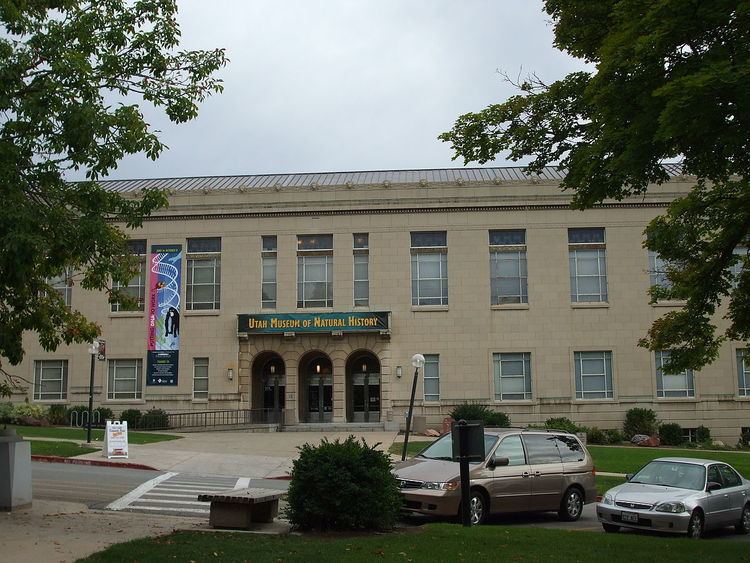Established 1963 Visitors 278,000 annually Phone +1 801-581-6927 | Type Natural history Founded 1963 | |
 | ||
Hours Open today · 10AM–9PMWednesday10AM–9PMThursday10AM–5PMFriday10AM–5PMSaturday10AM–5PMSunday10AM–5PMMonday10AM–5PMTuesday10AM–5PMSuggest an edit Similar Hogle Zoo, LDS Conference Center, Utah State Capitol, Family History Library, Salt Lake Tabernacle Profiles | ||
Natural history museum of utah rio tinto center at the university of utah
The Natural History Museum of Utah (NHMU) is a museum located on the campus of the University of Utah in Salt Lake City, Utah, United States. The museum shows exhibits of natural history subjects, with an emphasis on Utah and the Intermountain West. The mission of the museum is to illuminate the natural world and the place of humans within it. The new building, named the Rio Tinto Center, opened in November 2011.
Contents
- Natural history museum of utah rio tinto center at the university of utah
- History
- Collections and research
- Anthropology
- Paleontology
- Entomology
- Vertebrate zoology
- Mineralogy
- Botany
- Malacology
- Permanent exhibitions
- Special exhibitions
- Educational programs
- Outreach
- Role at the University of Utah
- References
History
The museum was conceived in 1959, when the University of Utah faculty committee decided to consolidate natural history collections from around its campus. The museum was established as the Utah Museum of Natural History on the University of Utah campus in 1963 by the Utah State Legislature. It opened in 1969 in the former George Thomas Library and included specimens from the Deseret Museum as well as from the Charles Nettleton Strevell Museum that was located in the old Lafayette School on South Temple Street from 1939 until 1947.
In 2011 the museum moved from the old George Thomas Library location at 1390 Presidents Circle into the Rio Tinto Center, in the University of Utah's Research Park 301 Wakara Way, Salt Lake City. The move also resulted in a change of name to the Natural History Museum of Utah.
The Rio Tinto Center is a 163,000-square-foot building set in foothills of the Wasatch Mountains. The building's highest point is a round structure on the back or east side which houses the Native Voices gallery. The architects for the building were Ennead Architects from New York City and GSBS of Salt Lake City. Ralph Appelbaum Associates designed the exhibits.
Collections and research
The Natural History Museum of Utah has more than 1.3 million objects in its collection that are used for research and education. The Museum's collections emphasize the natural history of Utah and are accessible to researchers from around the world. The majority of the collections are from public lands within the inter-mountain region of the United States.
Collections are used in studies on geological, biological and cultural diversity, and the history of living systems and human cultures within the Utah region. The goal of the museum is to increase the collections while providing the widest possible access to that information.
Anthropology
1,000,000 objects.
The curator of anthropology is Duncan Metcalfe, and the collections manager is Glenna Nielsen-Grimm.
Paleontology
12,000 vertebrates, 4,000 invertebrates, and 7,000 plants.
Entomology
140,000 specimens.
Vertebrate zoology
30,000 mammals, 20,000 birds, and 18,000 reptiles.
Mineralogy
3,700 minerals.
Botany
123,000 specimens.
Malacology
25,000 specimens.
Permanent exhibitions
The Museum has ten permanent exhibitions.
Special exhibitions
The Museum houses a special exhibition gallery with rotating special exhibitions.
Educational programs
The educational programs are organized by the School Programs Department. Development of school programs is closely tied to the public school system's core curriculum. The museum's educational programs include:
Outreach
Role at the University of Utah
The museum is part of the academic life of the University of Utah. The collections offer research opportunities and provide a learning laboratory for students. Museum programs expose students to many aspects of museum studies: educational outreach, exhibit design and fabrication development, public relations, and curriculum development.
The museum is a repository for collections that were accumulated by the university's departments of Anthropology, Biology, and Geology. The collections are held in trust for faculty, graduate students, and undergraduates who have access to the collections for research and teaching purposes.
In-service training is offered by the Utah Museum of Natural History Education Department; university credit can be earned with these courses, leading to salary lane changes for public school teachers. These courses are coordinated with the Academic Outreach and Continuing Education and the Department of Teaching and Learning. As the founder of the University’s Genetic Science Learning Center, the museum continues to partner in its teacher training program.
The museum meeting rooms are available for rental for on- and off-campus groups.
